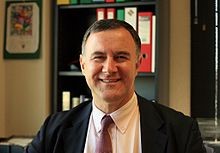Miguel A.F. Sanjuán receives the Chieh-Su Hsu Award 2020#
Prof. Miguel A.F. Sanjuán, Professor of Physics at the University Rey Juan Carlos, Madrid, Spain, and Editor General of the Spanish Royal Physics Society (RSEF) has received the Chieh-Su Hsu Award 2020 granted by the Nonlinear Science and Complexity Conference Series Awards for his outstanding achievements in Chaos Theory opening new perspectives on
predictability in Nonlinear Dynamics and Complexity.
granted by the Nonlinear Science and Complexity Conference Series Awards for his outstanding achievements in Chaos Theory opening new perspectives on
predictability in Nonlinear Dynamics and Complexity.
Prof. Sanjuán was elected as a member of the Physics and Engineering Sciences section of the Academy in 2017.
This award, has been given in its first edition in 2020 in memory of Prof. Chieh-Su Hsu , Professor of Applied Mechanics, UC Berkeley.
, Professor of Applied Mechanics, UC Berkeley.
Academia Europaea congratulates Prof. Sanjuán to this distinction! #
2020 C.S. Hsu Award Recipients#
(http://ndc.lhscientificpublishing.com/c-s-hsu-awardee-2020-miguel-sanjuan )#
)#
Miguel A. F. Sanjuán#
Statement of achievements#
He has contributed to develop a particular method of chaos control, which is called “partial control” in collaboration with Prof. James Yorke (“Dynamics of Partial Control”. Chaos 22, 047507, 2012). The method is applied in situations where there is transient chaos in presence of noise, and the striking idea is that the system can be controlled with a control smaller than noise. The method has been applied so far to numerous dynamical systems, and to problems ranging from ecology to dynamics of cancer.
He has also made seminal contributions to vibrational resonance and nonlinear resonances. His monograph on “Nonlinear Resonances” co-authored with Prof. Rajasekar is having a fundamental impact in the development of the field, with applications in numerous different fields.
He has made several significant contributions to the modeling of biological systems, including the analysis of map-based models in neuronal dynamics (Physics Reports 501(1-2), 1-74, 2011), and has pioneered a new research line on physics and dynamics of cancer.
Other of his contributions focus on applications of nonlinear and chaotic dynamics in Physics, Galactic Dynamics, Chaos and Entanglement, Cold Atoms, and Black Holes. A second edition of the book “Predictability of Chaotic Dynamics” co-authored with J.C. Vallejo has recently appeared. Furthermore, he has strongly contributed to the education of new researchers in the field, by mentoring more than 20 PhD Students, and establishing many international collaborations with 100+ different co-authors of 20+ different nationalities. He has led a research group in NLD, served in many editorial boards on NLD, and created university master programs to teach NLD.
Nonlinear Dynamics and Complexity
Online Conference


